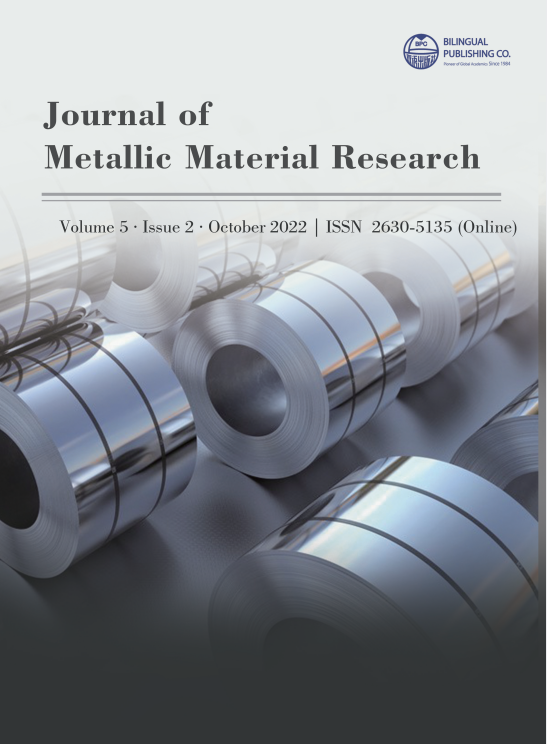-
192
-
155
-
147
-
132
-
114
As-Cast Microstructures of High Entropy Alloys Designed to Be TaC-Strengthened
DOI:
https://doi.org/10.30564/jmmr.v5i2.4685Abstract
In this work two new alloys were obtained by extrapolation from a well known high entropy alloy, the equimolar CoNiFeMnCr one. This was done by the addition of carbon and of tantalum, Ta being one of the strongest MC-former elements. They were produced by conventional casting under inert atmosphere. The obtained microstructures were characterized by X-ray diffraction, metallography, electron microscopy, and energy dispersion spectrometry. Their hardness was also measured by hardness indentation. In parallel, the original CoNiFeMnCr alloy was also synthesized and characterized for comparison. The reference HEA alloy is single-phased with an austenitic structure, while the two {Ta, C}-added alloys are double-phased, with an austenitic matrix and interdendritic script-like TaC carbides. The matrixes of these HEA/TaC alloy are equivalent toan equimolar CoNiFeMnCr alloy to which 2 wt.% Ta is present in solid solution. The presence of the TaC carbides caused a significant increase in hardness which suggests that the HEA/TaC alloys may be mechanically stronger than the HEA reference alloy at high temperature.Keywords:
HEA alloys; TaC carbides; As–cast microstructures; HardnessReferences
[1] Chester, T.S., Hagel, W.C., 1972. The Superalloys-Vital High Temperature Gas Turbine Materials for Aerospace and Industrial Power. John Wiley & Sons: New York.
[2] Sims, C.T., Stoloff, N.S., Hagel, W.C., 1987. Superalloys II. High: Temperature materials for aerospace and industrial power. John Wiley & Sons: New York.
[3] Kracke, A., Allvac, A., 2010. Superalloys, the most successful alloy system of modern times-past, present and future. Proceedings of the 7th International Symposium on Superalloy. 718, 13-50.
[4] Liu, S.F., Wu, Y., Wang, H.T., et al., 2018. Stacking fault energy of face-centered-cubic high entropy alloys. Intermetallics. 93, 269-273. DOI: http://dx.doi.org/10.1016/j.intermet.2017.10.004
[5] Ferrari, A., Körmann, F., 2020. Surface segregation in Cr-Mn-Fe-Co-Ni high entropy alloys. Applied Surface Science. 533, 147471. DOI: https://doi.org/10.1016/j.apsusc.2020.147471
[6] Wilson, P., Field, R., Kaufman, M., 2016. The use of diffusion multiples to examine the compositional dependence of phase stability and hardness of the Co-Cr-Fe-Mn-Ni high entropy alloy system. Intermetallics. 75, 15-24. DOI: http://dx.doi.org/10.1016/j.intermet.2016.04.007
[7] Do, H.S., Choi, W.M., Lee, B.J., 2022. A thermodynamic description for the Co-Cr-Fe-Mn-Ni system. Metals and Corrosion. 57, 1373-1389. https://link.springer.com/article/10.1007/s10853-021-06604-8.
[8] Kawamura, M., Asakura, M., Okamoto, N.L., et al., 2021. Plastic deformation of single crystals of the equiatomic Cr−Mn−Fe−Co−Ni high-entropy alloy in tension and compression from 10 K to 1273 K. Acta Materialia. 203, 116454. DOI: https://doi.org/10.1016/j.actamat.2020.10.073
[9] Osintsev, K., Konovalov, S., Zaguliaev, D., et al., 2022. Investigation of Co-Cr-Fe-Mn-Ni non-equiatomic high-entropy alloy fabricated by wire arc additive manufacturing. Metals. 12, 197. DOI: https://doi.org/10.3390/met12020197
[10] Hu, M., Cao, Q.P., Wang, X.D., et al., 2022. Tuning nanostructure and mechanical property of Fe−Co−Ni−Cr−Mn high-entropy alloy thin films by substrate temperature. Metals. 12, 197. DOI: https://doi.org/10.1016/j.mtnano.2021.100130
[11] Mehranpour, M.S., Shahmir, H., Nili-ahmadabadi, M., 2021. Precipitation kinetics in heavily deformed CoCrFeNiMn high entropy alloy. Materials Letters. 288, 129359. DOI: https://doi.org/10.1016/j.matlet.2021.129359
[12] Xiao, H., Zeng, Q., Xia, L., et al., 2022. Hydrogen-assisted fatigue crack propagation behavior of equiatomic Co-Cr-Fe-Mn-Ni high-entropy alloy. Materials and Corrosion. 73, 550-557. DOI: https://doi.org/10.1002/maco.202112866
[13] Kim, Y.K., Joo, Y.A., Kim, H.S., et al., 2018. High temperature oxidation behavior of Cr-Mn-Fe-Co-Ni high entropy alloy. Intermetallics. 98, 45-53. DOI: https://doi.org/10.1016/j.intermet.2018.04.006
[14] Zhu, Z.G., Ma, K.H., Yang, X., et al., 2017. Annealing effect on the phase stability and mechanical properties of (FeNiCrMn)(100-x)Cox high entropy alloys. Journal of Alloys and Compounds. 695, 2945-2950. DOI: http://dx.doi.org/10.1016/j.jallcom.2016.11.376
[15] Dong, J., Feng, X., Hao, X., et al., 2021. The environmental degradation behavior of FeNiMnCr high entropy alloy in high temperature hydrogenated water. Scripta Materialia. 204, 114127. DOI: https://doi.org/10.1016/j.scriptamat.2021.114127
[16] Zhang, C., Zhang, F., Jin, K., et al., 2017. Understanding of the elemental diffusion behavior in concentrated solid solution alloys. Journal of Phase Equilibria and Diffusion. 38, 434-444. DOI: https://doi.org/10.1007/s11669-017-0580-5
[17] Bracq, G., Laurent-Brocq, M., Varvenne, C., et al., 2019. Combining experiments and modeling to explore the solid solution strengthening of high and medium entropy alloys. Acta Materialia. 177, 266-279. DOI: https://doi.org/10.1016/j.actamat.2019.06.050
[18] Szklarza, Z., Lekki, J., Bobrowski, P., et al., 2018. The effect of SiC nanoparticles addition on the electrochemical response of mechanically alloyed CoCrFeMnNi high entropy alloy. Materials Chemistry and Physics. 215, 385-392. DOI: https://doi.org/10.1016/j.matchemphys.2018.05.056
[19] Berthod, P., Bernard, J.L., Liébaut, C., 2001. Cobalt-chromium alloy for spinner cups in manufacture of mineral wool from silicate glass. International Patent, PCT International Applications. WO 2001090429 A1 20011129.
[20] Michon, S., Aranda, L., Berthod, P., et al., 2004. High temperature evolution of the microstructure of a cast cobalt base superalloy-Consequences on its thermomechanical properties. Metallurgical Science and Technology. 101, 651-662. DOI: https://doi.org/10.1051/metal:2004116
[21] Berthod, P., Aranda, L., Vébert, C., et al., 2004. Experimental and thermodynamic study of the high temperature microstructure of tantalum containing nickel-based alloys. Calphad. 28, 159-166. DOI: https://doi.org/10.1016/j.calphad.2004.07.005
[22] Michon, S., Berthod, P., Aranda, L., et al., 2003. Application of thermodynamic calculations to study high temperature behavior of TaC-strengthened Co-base superalloys. Calphad. 27, 289-294. DOI: https://doi.org/10.1016/j.calphad.2003.12.003
[23] Berthod, P., Hamini, Y., Aranda, L., et al., 2007. Experimental and thermodynamic study of tantalum-containing iron-based alloys reinforced by carbides: Part I — Case of (Fe, Cr)-based ferritic steels. Calphad. 31, 351-360. DOI: https://doi.org/10.1016/j.calphad.2007.01.007
[24] Berthod, P., Aranda, L., Hamini, Y., et al., 2007. Experimental and thermodynamic study of tantalum-containing iron-based alloys reinforced by carbides: Part II — Case of (Fe, Ni, Cr)-base austenitic steels. Calphad. 31, 361-369. DOI: https://doi.org/10.1016/j.calphad.2007.01.008
[25] Berthod, P., Corona, L., 2017. Thermodynamic and experimental study of 30 wt-%Cr-containing {Co, Fe or Ni}-based alloys with very high contents in Ta and C. Canadian Metallurgical Quarterly. 56, 113-122. DOI: http://dx.doi.org/10.1080/00084433.2016.1267298




 Patrice Berthod
Patrice Berthod






